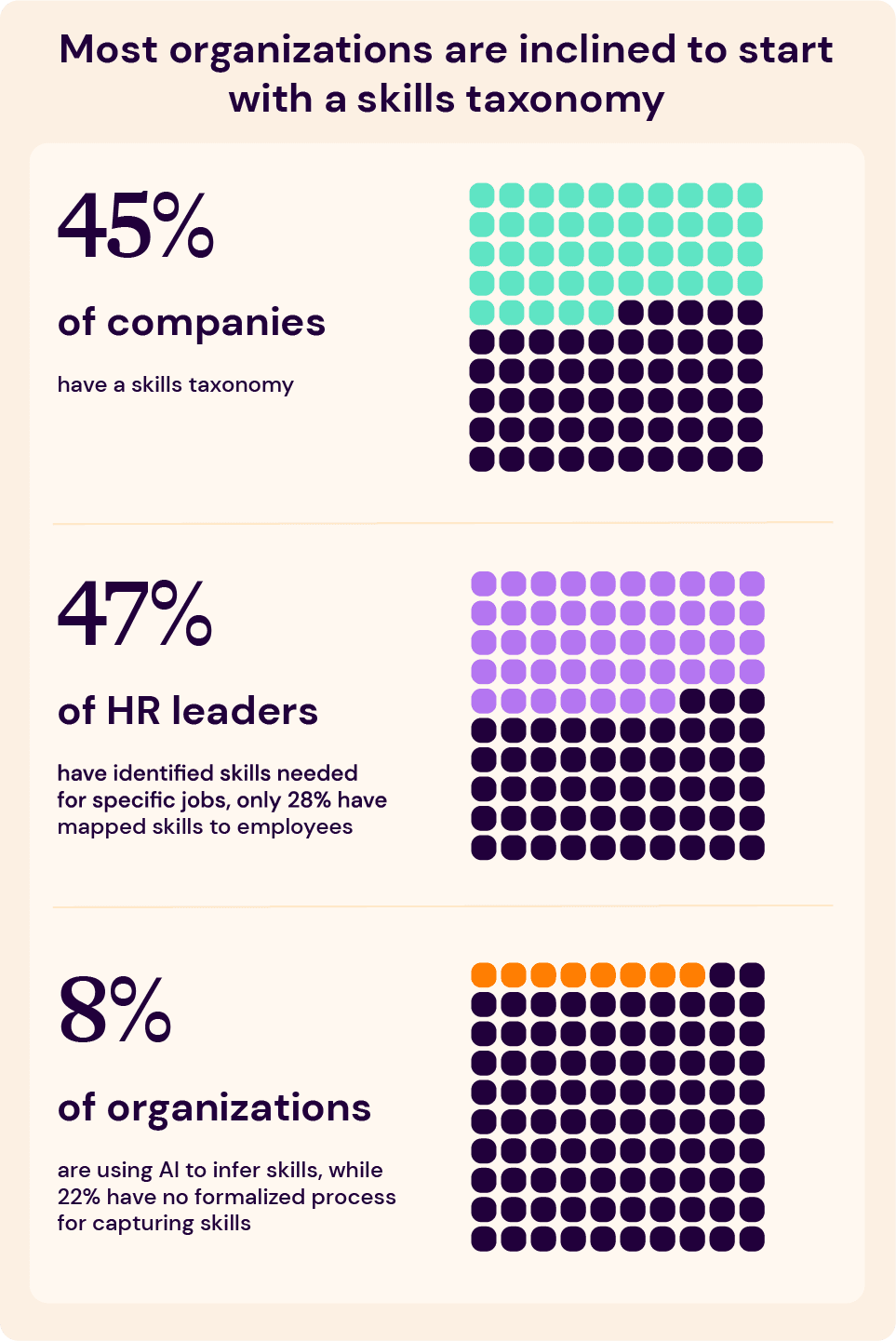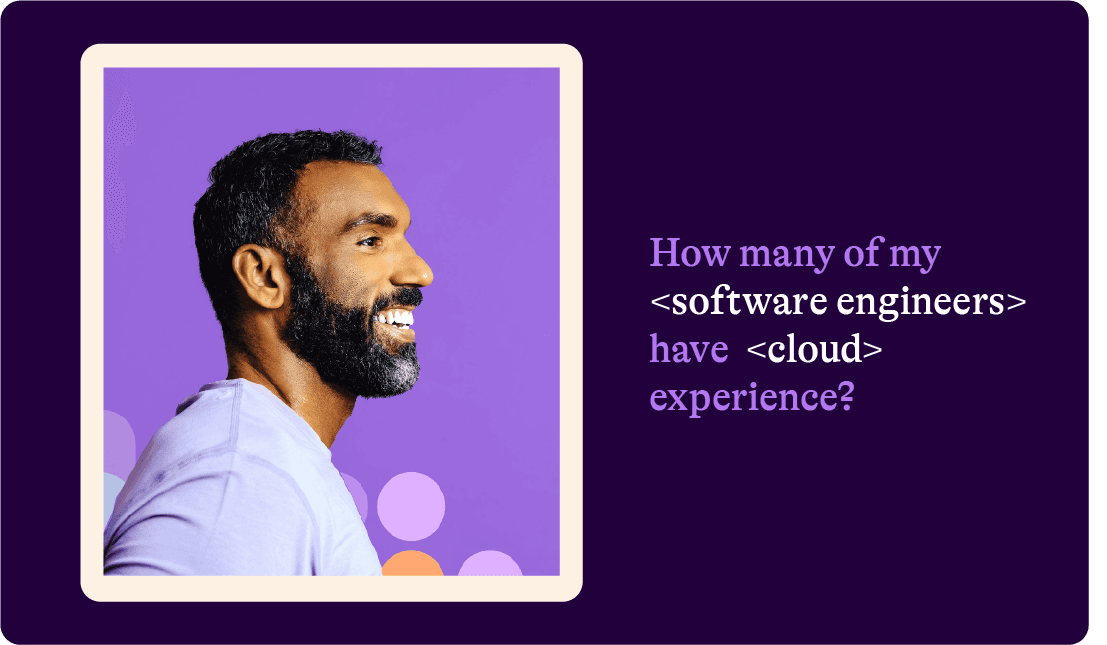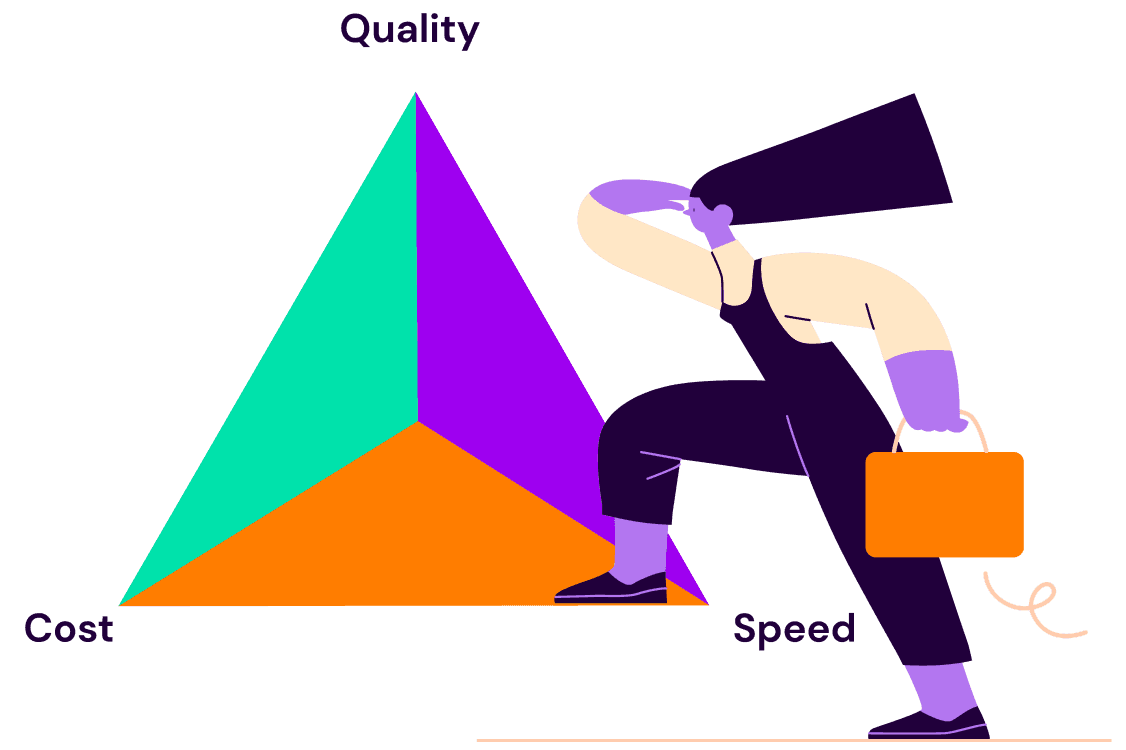
Back to blogs

Understanding Talent vs. Skill to Build Impactful Teams in the Workplace
Traditionally, talent and skill have respectively been presented as the difference between innate and learned abilities or natural gifts compared to those acquired through training and practice. However, the way in which each of these has been applied to build successful teams in the workplace is changing. The source of someone’s ability is not as helpful as how they use it to impact business outcomes.
In this article, we’ll cover the difference between skill and talent and frame talent vs. skill largely from the perspective of recruiting teams who aim to hire and develop employees to drive business results. You’ll learn about the tools and processes organizations can use to understand their employees’ skills and how a perspective shift about skills and talents empowers individuals and their professional development.
How do you define skill?
A skill can refer to the array of abilities, knowledge, and expertise that individuals possess and use to perform tasks and solve problems. Skills can be categorized into three different types: hard skills, soft skills, and capabilities. Each type can play a crucial role in shaping a candidate's suitability and potential for success in specific job roles.
Skill type | Definition and examples |
|---|---|
Hard skills | Demonstrate the ability to perform a task through technical, operational, or functional proficiencies. Hard skills are not a predictor of one’s success—they’re table stakes to qualify for a role. This type of knowledge should be used to screen out candidates—do they know this coding language, this medical procedure, this marketing operation, etc.? |
Soft skills | Demonstrate a candidate’s ability to interact with others, solve problems, and manage their work. Soft skills—like leadership, communication, and collaboration—are often hard to assess from a resume but can be examined during an interview through behavioral and attitude questions. |
Capabilities | The ability to apply a collection of hard skills, soft skills, and knowledge in a particular context to achieve a certain outcome. Skills are the foundational building block of capabilities and can be transferable from one job to another. For example, the skill of active listening is critical for a UX researcher and can also be transferred to the job of a Customer Success Manager. |
Examples of skills: How all three skill categories come together
Performing at a concert is a capability, and it requires skills such as proficiency with an instrument (hard skill), stress management (soft skill), and audience interaction (soft skill).
Startup fundraising is a capability, and it requires skills such as negotiation (soft skill), financial modeling (hard skill), market research (hard skill), and resilience (soft skill).
How do you define talent?
Talent is commonly referred to as a natural aptitude that someone is born with and may come to them effortlessly. However, talent can also be developed—despite not being “good” at something naturally, someone’s dedication and drive to learn can steer them toward honing a talent.
When applied to the workplace, talent encompasses an individual’s potential to succeed when applying their skills and capabilities in different situations. It seems fitting then, that HR and managers often refer to people they’re hiring or developing in their organization as “talent.”
This aligns nicely with the idea that employees should be able to bring their whole selves to the workplace, as well as the skills-based movement toward seeing employees for their full capabilities, not just the skills they use for a specific job function.
Talent vs. skills in the era of the “skills-based organization”
As companies strive to become skills-based organizations, it’s more critical than ever that you know what to look for while investing in understanding employees’ talents and skills. What are the indicators that a candidate or employee can impact the business? What data about skills will effectively inform strategic HR initiatives?
Why it's time for HR and leadership to rethink talent vs. skill
Most of the conversations about building organizational talent strategies based on skills are framed from the viewpoint of HR professionals. However, for business leaders, a successful talent strategy begins with specific business objectives—like increasing revenue, strengthening a competitive position in the market, expanding into a new market, etc. From here, you can break down business goals into key initiatives to understand the jobs to be done and evaluate the teams, roles, and skills needed to execute the work.
From this perspective, the most critical characteristics to look for in job candidates are likely not the same hard skills and attributes that hiring managers and HR spend so much time aligning on. Rather, it’s how talent is applied across experiences—especially soft skills and capabilities that speak to how skills are used in context—that determines how successful people are in achieving business goals.
Unfortunately, some hiring managers and even recruiting software platforms rely too heavily on skills when matching candidates to jobs. The capabilities and soft skills that define a person’s talents are really what hiring managers should look for to indicate whether a candidate will succeed.
In the context of hiring or professional development, it’s not very helpful to think of skills as checking a box to indicate that a person has a certain ability. Perhaps we shouldn’t think of skills as nouns—instead, it’s more helpful to think beyond skills and consider capabilities and talents as verbs, applying context to how various skills were used to drive outcomes. What was the context for using that skill? What did they accomplish as a result?
Managing skills in this way not only demands thinking differently about people and their skills but also requires more advanced technology to understand skills in the context of what people have done, not simply extracting keywords as skills.
How organizations can understand an individual’s skills
Organizations traditionally lean into the following tools to help them understand how candidate skills can best align with their talent roadmap.
Competency model
A competency model is a structured framework that defines the specific skills, knowledge, behaviors, and abilities required for an individual to perform effectively in a particular job or role within an organization. It often includes multiple levels of proficiency and can be used across various job families or industries. Competency models help HR and talent management by providing a clear blueprint for what is needed for success in specific positions, which can guide recruitment, performance management, and development initiatives.
Skills assessment
A skills assessment is a systematic process used to evaluate an individual's abilities and competencies in specific areas relevant to a job role. This evaluation can include various methods such as tests, practical exercises, simulations, and self-assessments. Skills assessments help organizations determine whether employees or job candidates possess the necessary skills to perform effectively in their roles. They may guide decisions related to hiring, training, and career development by aligning individual capabilities with organizational needs and goals.
How can you understand the talent and skills of your workforce?
Organizations can create a database of their employees’ skills, like a skills inventory or skills matrix, but this process is traditionally manual and, therefore, time-consuming. Here are common methodologies used with an explanation of an AI-driven approach that solves the pains of these manual processes.
Skills inventory
A skills inventory is a comprehensive database or list that captures information about the skills and competencies of each individual employee within an organization. It includes details such as technical skills, soft skills, certifications, and other relevant qualifications. This enables HR and management to have a clear overview of the skills available within the workforce, which can help in facilitating workforce planning, talent management, and decision-making related to talent acquisition, development, and deployment. To get there, many are inclined to start with a skills taxonomy, which is discussed in the following section.

Skills taxonomy
A skills taxonomy is a hierarchical classification or categorization of skills within an organization. Having a structured framework that organizes skills into a system of categories and subcategories creates a standardized way to identify and describe different skills.
Historically, traditional skills taxonomies have been fixed and static, with each of its tens of thousands of skills corresponding to a specific definition, ability, or credential. The more comprehensive, the better it will match a candidate’s skills to the requirements in a job description.
The way our brains can think about skills to make talent decisions today is vastly more complex than what most traditional technology, like a skills taxonomy, has been able to offer. But now, thanks to generative AI, that gap is closing—bringing with it the opportunity to build skills-based organizations with a different approach.
Skills ontology
A skills ontology is a more advanced and dynamic representation of skills that goes beyond a simple taxonomy. By utilizing a non-linear, graph data structure, an ontology represents skills in a more interconnected and context-aware manner that helps capture more nuanced relationships between skills. This affords a deeper understanding of how skills relate to each other, which skills are transferable and adjacent, and how skills have evolved. This also enables more sophisticated talent management, workforce planning, and analytics.
Dynamic skills system
A dynamic skills system is an AI-assisted skills ontology that uses both publicly available and internal, integrated data sources to help organizations understand the talents and skills of their workforce and the market. SeekOut’s talent intelligence platform is an example of a dynamic skills system.
How does a dynamic skills system work?
You can turn to a dynamic skills system to help you understand the skills of certain employees who have worked in different functional areas or on specific types of projects. Let's say your company is trying to get into a new product area, virtual reality—but you don’t have virtual reality in your job architecture, or a skills taxonomy to understand the skills needed related to this new area.
In real time, the system can look at employees’ profiles who fit certain criteria (for example, “a software engineer working on virtual reality at Meta”) as well as job posting data. With these data sets, and crunching through a lot of natural language, the system not only pulls out relevant skills, but dynamically categorizes them into groups and subgroups spanning functional, technical, behavioral skills, and so on.
Next you can analyze the relationships of related skills to virtual reality in different contexts based on your needs. For example, virtual reality in a game development setting may display prerequisite skills like animation and audio design. But what if your company is doing VR for medical applications? You’d see a different set of prerequisite skills—like anatomy and physiology. The system understands how these skills are related through the context provided because of generative AI’s powerful capabilities at the semantic level.

Another powerful use case is understanding the adjacent skills of emerging skills. For example, an emerging need at your organization may be for “green skills”—but what does this mean? Generative AI can help you take a stab at defining it, or you can add a definition into the system in natural language. In this case, a dynamic skills system may return “carbon footprint reduction,” “resource efficiency,” and “Corporate Social Responsibility” as adjacent to “green skills.”
How AI is helping organizations understand skill vs talent
Advancements in AI are enabling new insights at scale by aggregating data to get a holistic view of a workforce’s capabilities. Today, seeing a complete picture of your talent requires unifying a huge amount of disparate data across varying sources:
Internal HR systems like your HRIS, ATS, LMS, and salary, performance, and other internal data;
Internal productivity tools like GitHub, Jira, Salesforce, and others;
External sources like public LinkedIn profiles, GitHub, StackOverflow, papers and patents, federal and state licensing board data, and more.
Connecting and making sense of this much data is a much simpler task for AI, where it would require weeks or months of work for humans to manually join these data sources in a way that’s useful.
Generative AI also goes beyond keywords to provide a deeper understanding of a candidate’s or employee’s skills and the impact they had. For example, AI may infer whether certain projects involved cross-departmental collaboration or where skills adjacencies exist that were not captured and represented explicitly on a resume or in your HRIS.
Finally, another huge value of AI is the ability to enrich this information on an ongoing basis without a heavy manual lift. This means you spend less time on maintenance and focus more on strategic applications of skills and talent—like market analysis, recruiting, internal development, workforce planning, and strengthening your competitive positioning.
Learn more about building a skills-based organization with AI
Read our Future of Skills whitepaper to learn more about the evolution of the skills-based organization and how to embrace AI to help you address talent problems with skills.
See us in action
Learn how SeekOut unifies people data to help organizations reach their talent goals
Request a demo



